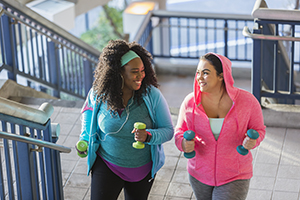As the holidays draw to a close, 29 million Americans with type 2 diabetes had to navigate the minefield of treats, drinks, and dinners. Many patients have stepped up to meet the challenge of moderating their diet, but fewer embrace the benefits of physical activity in controlling their blood sugar.
A research team led by scientists at University of Utah Health have developed an online interactive app to help motivate patients to be more physically activity to manage their disease. The results are published in the January 9 issue of the Journal of Medical Internet Research.

A video detailing this project is available here.
According to Nancy Allen, Ph.D., ANP-BC, assistant professor in the College of Nursing at U of U Health and co-author on the paper, there is an emotional component to behavior change. Convincing patients to increase their physical activity to maintain their blood sugar levels is easier said than done.
In addition, this disease commonly co-occurs with obesity, which sets off a dangerous cycle. Overweight patients experience joint pain, limiting their ability or desire to engage in physical activity. As patients limit their physical activity, they gain more weight, worsening their disease.
To overcome these hurdles, the research team developed the interactive app to gauge participant understanding of the effect of physical activity in managing their disease and motivate them toward this important behavioral change.
At the start, the user enters their blood sugar (A1c) value and some basic vital information. Using this input, the program draws an average blood sugar curve, which is based on the patient’s A1c value. The participant then uses a mouse to draw a line along the rising and falling blood sugar curve to illustrate how they expect their blood sugar would change following 30 minutes of exercise, like walking.
Next, the user controls slider that change the duration of exercise or time of day exercise occurs. The program reveals how blood sugar actually changes from the average blood sugar curve following a period of physical activity. The participant can see the difference between their expected and the actual curves. The results are often dramatically different.
“Based on prior work, we thought people would underestimate the impact of physical activity, but we were wrong,” said Bryan Gibson, D.P.T, Ph.D., assistant professor in Biomedical Informatics at U of U Health and first author on the paper. “The patients overestimated the impact of physical activity on their blood sugar, but after using the simulation their motivation still increased.”
Gibson believes the participants were swayed when the results affirmed their beliefs of the positive effect of physical activity on blood sugar.
More importantly, the patient can run the app multiple times to explore how the time of day and length of physical activity affect blood sugar levels. Through this process, they can pinpoint the optimal time for their exercise to reap the most benefits.
The researchers found the app provided an effective way to change patients’ attitude toward physical activity and shift their beliefs to incorporate more exercise into their daily routine. In fact, the participants on average increased their plans to walk for exercise in the next week by more than 30 minutes (from 67.1 minutes pre-study to 100.5 minutes post-study).
“I see this as a tool that educators can use in their office to help patients make the visual connection between the power that they have with physical activity and diabetes management,” Allen said.
Of the 2,019 participants who visited the website, 1,335 (566 male; 765 female) submitted completed data. Of which, 77 percent were Caucasian and 15 percent were Hispanic, African American, American Indian or Native America, and Pacific Islander. According to Oakley-Girvan, the next project will include a participation pool that more closely mirrors the U.S. population managing this disease.
In the future, the research team hopes to adapt this approach to personalize the app by creating patient-specific blood sugar curves using a glucose monitor and an activity monitor rather than rely on average blood sugar curves. In addition, they hope to integrate this work into the clinical care setting to give providers additional tools to help educate their patients. The team also wants to leverage the power of social engagement by integrating the app into a supportive group setting.
“Exercise is a natural part of your daily living,” said Ingrid Oakley-Girvan, Ph.D., M.P.H, a research scientist at the Cancer Prevention Institute of California and co-author on the study. “Sitting is the new smoking, but our technology empowers patients to understand how exercise improves their health.”
This project, titled An Interactive Simulation to Change Outcome Expectancies and Intentions in Adults with Type-2 diabetes: Within-Subjects Experiment, was published in the Journal of Medical Internet Research. The research team also includes Leah Yingling and Ashwini Janamatti, graduate students at U of U Health, and Alisa Bednarchuk, RN, the Indian Health Service at Browning, Mont.
